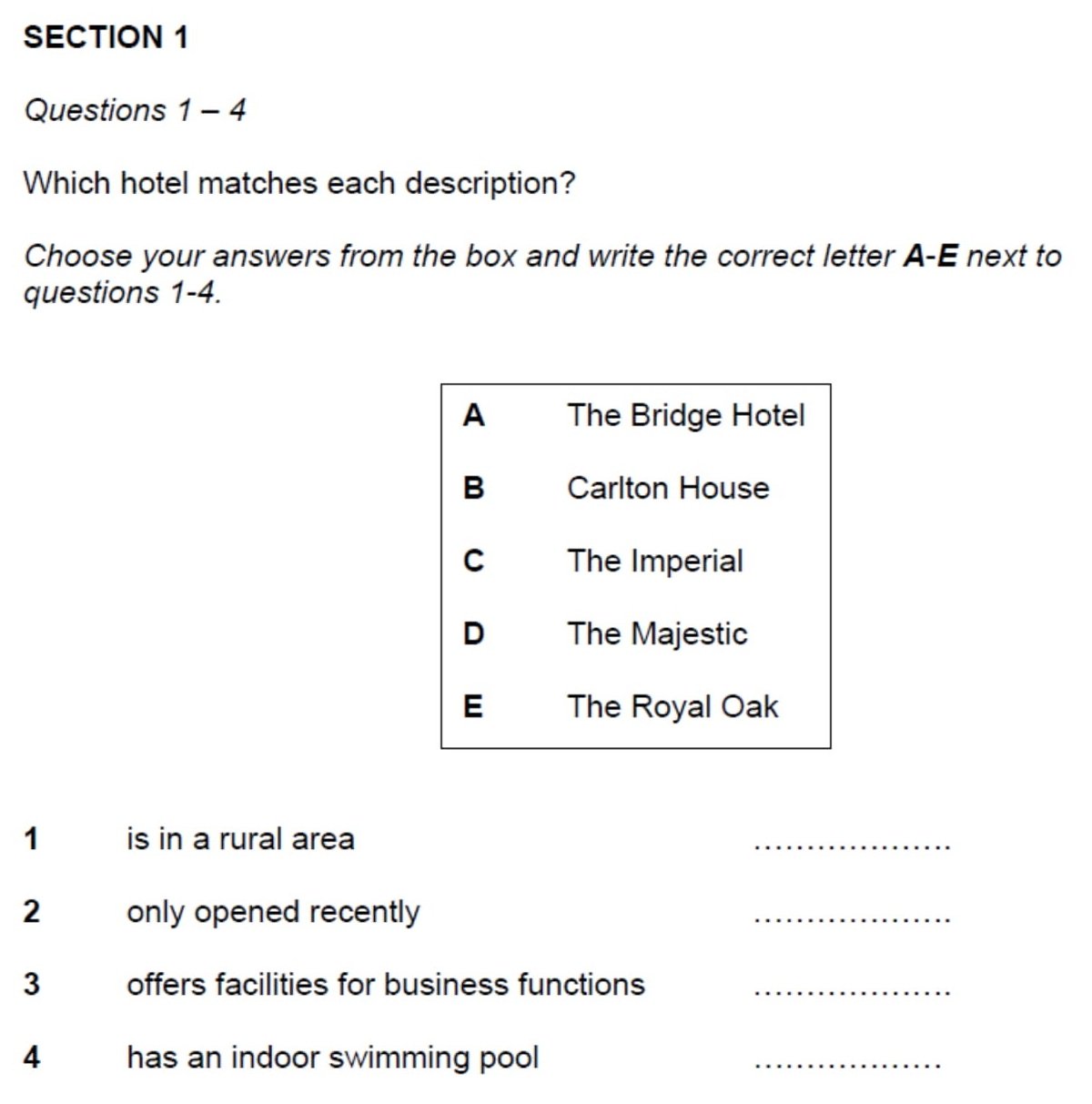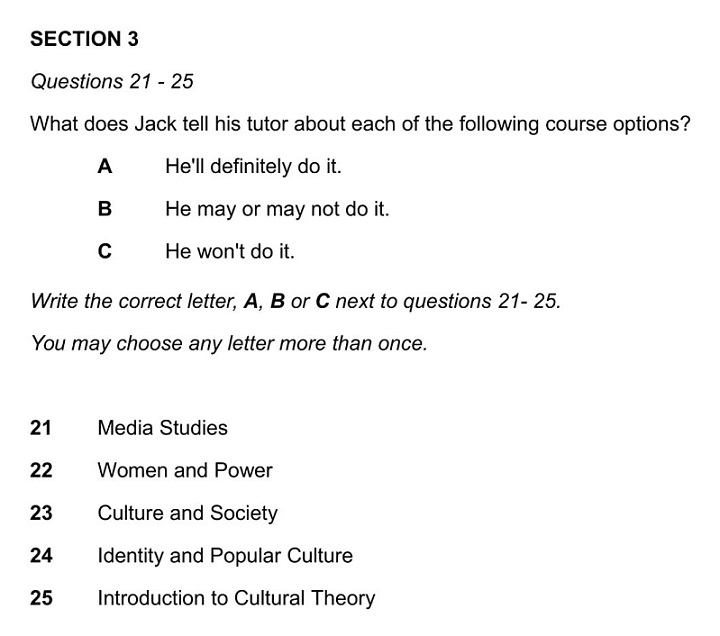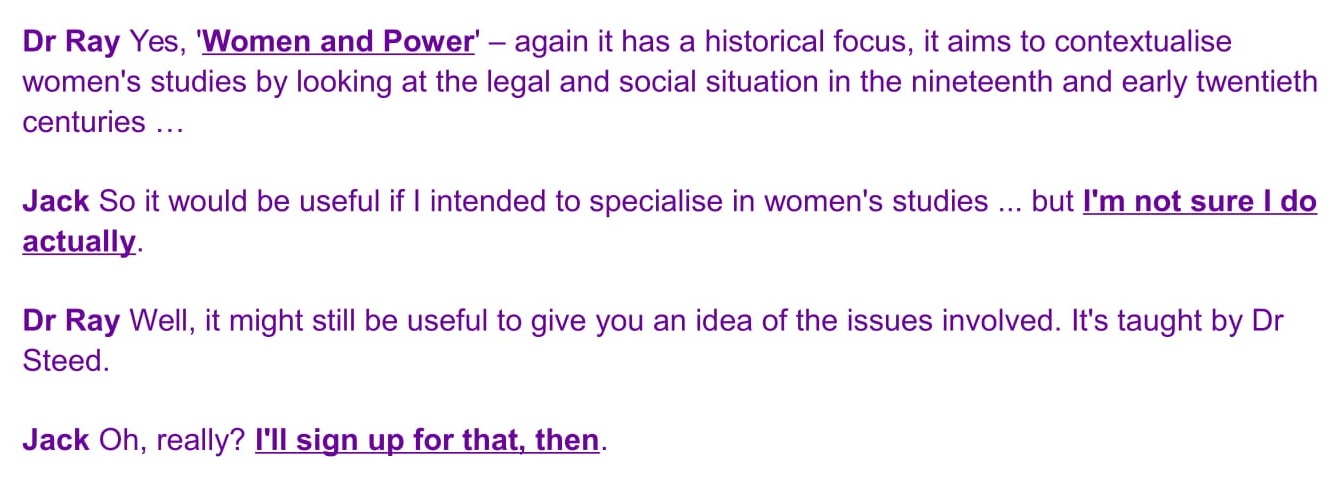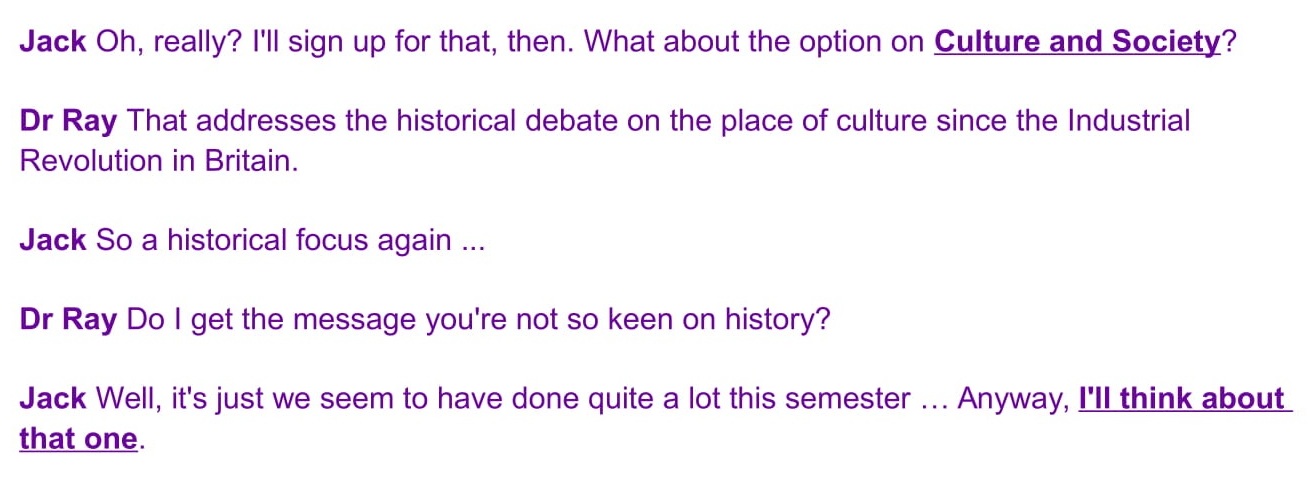IELTS Listening
Matching Questions
Matching
questions are very common in the IELTS Listening exam, so expect to get one in
your test.
This type of question usually appears in sections 1 or 3 in which the recording is a conversation between two or more people. The question will contain two sets of information and you have to match them.
You need to have a good strategy to answer matching questions successfully and that’s what you’ll learn in this lesson.
The lesson includes:
- Question types
- Sample questions
- Strategy & tips
- Practice question
- Answers
- Vocabulary
Matching questions come in several different forms. Here are a couple of examples from past papers.
IELTS Listening matching questions – Sample 1
In this example, you are given a list of hotel names (A-E) and a list of features of the hotels (1-4). You must listen to the recording and identify which hotel has which feature.

Source: Cambridge English Test Paper
IELTS Listening matching questions – Sample 2
In this example, you are given a list of course options (21-25) and a list of choices the student could make about whether or not he will take the course. You must listen to the recording and identify the decision the student makes about each course.

Source: Cambridge English Test Paper
I’m going to use this second example to teach you the answer strategy and give you tips and advice on how to overcome the challenges presented by this type of question.
Strategy & Tips
You will have a short time to prepare before the speakers begin talking. Use this time to familiarise yourself with the question and focus your mind on what you need to listen out for.
1) Analyse the question
One of the biggest challenges with matching questions in the IELTS listening test is that they can be confusing when you first see them, so start by analysing the question to make sure you fully understand what you have to do.
Step 1 – First, you need to understand the relationship between the question sentence and the question options 21-25.
Highlight the key part of the question sentence and think about how it relates to the question options.
What does Jack tell his tutor about each of the following course options?
A He'll definitely do it.
B He may or may not do it.
C He won't do it.
Write the correct letter, A, B or C next to questions 21- 25. You may choose any letter more than once.
21 Media Studies
22 Women and Power
23 Culture and Society
24 Identity and Popular Culture
25 Introduction to Cultural Theory
So, you will need to listen out for what Jack tells his tutor about Media Studies, what he tells her about Women and Power, and so on.
Step 2 – Next, look at questions 21-25 in relation to the answer options A, B and C.
What does Jack tell his tutor about each of the following course options?
A He'll definitely do it.
B He may or may not do it.
C He won't do it.
Write the correct letter, A, B or C next to questions 21- 25. You may choose any letter more than once.
21 Media Studies
22 Women and Power
23 Culture and Society
24 Identity and Popular Culture
25 Introduction to Cultural Theory
So, does Jack tell his tutor that he will definitely do Media Studies, he may or may not do Media Studies or that he won't do Media Studies?
Does Jack tell his tutor that he will definitely take the Women and Power course, he may or may not take the Women and Power course or that he won't take the Women and Power course? And so on.
2) Answer order
In matching questions, the questions will be mentioned in order in the recording but the answer options will appear randomly.
So, for our sample question, the speakers will first talk about Media Studies, then Women and Power, then Culture and Society, etc. The three decisions options as to whether or not to take each course could be heard in any order.
3) Synonyms and paraphrasing
Synonyms and paraphrasing will be used extensively in the recording and another good use of your preparation time is to quickly think of some words and phrases that might be used to express the information in the question.
First, let’s think about the three answer options. Jack is not going to say,
- I will definitely do the Introduction to Cultural Theory course.
- I may or may not do the Culture and Society course.
- I won’t do the Identity and Popular Culture course.
He will use different phrases to convey the same meaning. You will need to listen out for both positive and negative vocabulary and sentence structures. For example,
- I’m very interested in Women and Power so I think I’ll go for that one.
- I’ll give Media Studies a miss as I did a similar module last year.
If you can think up a few examples of what you might hear Jack say, you will be well prepared for picking out the synonyms and paraphrasing as the recording plays.
4) Watch out for distractors
The examiners will try and catch you out with distractors.
A distractor is a word or a phrase that changes or corrects the original piece of information given. So, you may be given an answer and then have it taken away again.
Here are some sample sentences containing distractors. I’ve highlighted the relevant words.
- I’d really like to study Identity and Popular Culture but I don’t like the lecturer so I’m not going to take it.
- I discounted Culture and Society. However, a friend took it last year and loved it, so I’m seriously considering it as on option.
‘But’ and ‘however’ are common distractor but there are many other words and phrases that can be used to change the information given. There are several present in the recording so listen carefully for them.
You will also hear Jack changing or clarifying decisions as the conversation progresses and he’s given new information by the tutor Dr Ray.
The best approach to marking the answers is to write A, B or C next to a question as soon as you think you’ve heard the correct answer but continue to listen carefully in case you find that you’re wrong. If this happens, you can quickly cross it through and write the correct answer beside it.
You can write on your test paper as much as you want to. You’ll have 10 minutes at the end of the Listening test to transfer your answers to the answer sheet.
5) Writing the answer
Read the question carefully.
Write the correct letter, A, B or C next to questions 21- 25. You may choose any letter more than once.
For matching questions in the IELTS Listening test, you must write a letter for the answer, not a word or phrase.
So, if the answers is ‘He'll definitely do it’, you must write A, not the sentence. If you write the words ‘He'll definitely do it’ for your answer, it will be marked wrong even though the information is correct. Don’t throw away marks with silly mistakes like this.
6) Predict the answer
In some questions, you may be able to predict some likely matches of information. This will help to quickly eliminate some of the possible answers.
This isn’t possible in this question but do bear it in mind as you practice with other sample questions.
7) Guess if necessary
My final tip is to never leave a blank space on the answer sheet. If you miss an answer, take an educated guess. This gives you at least some chance of getting it right. Don’t stress about a missed answer or it will affect your ability to answer the next set of questions. Just make your choice and move on.
Practice Activity
It’s now time for you to practice using this strategy on our sample question. Here it is again.
Sample matching question

Listen to this recording and answer the question. Refer back to the strategy as you need to. When you’ve completed the practice activity, go through the answers below.
Answers
Here are the correct answers. Examine the language that makes them correct, that is, the paraphrasing that has been used.
Answers:
21 Media Studies à C He won't do it.
22 Women and Power à A He'll definitely do it.
23 Culture and Society à B He may or may not do it.
24 Identity and Popular Culture à B He may or may not do it.
25 Introduction to Cultural Theory à C He won't do it.
Answer 21: C He won't do Media Studies.
Here’s the section of dialogue this answer appears in:

This is how the answer has been paraphrased:
He won't do it à but I’ve decided I'd rather do something completely new
Note the use of the distractor ‘but’ as Jack goes from a position of interest, which could suggest an answer of ‘maybe’, to a decision to definitely not do the course.
Answer 22: A He'll definitely do Women and Power.
Here’s the section of dialogue this answer appears in:

At first, Jack says that he is ‘not sure’ about taking women’s studies which suggests that he ‘may or may not do it’. When he hears that the tutor teaching the course is Dr Steed, he decides that he will definitely take this course.
This is how the answer has been paraphrased:
He'll definitely do it à I'll sign up for that, then
Answer 23: B He may or may not do Culture and Society
Here’s the section of dialogue this answer appears in:

This is how the answer has been paraphrased:
He may or may not do it à I'll think about that one
Answer 24: B He may or may not do Identity and Popular Culture
Here’s the section of dialogue this answer appears in:

This is how the answer has been paraphrased:
He may or may not do it à I might wait until then to decide
Answer 25: C He won't do Introduction to Cultural Theory
Here’s the section of dialogue this answer appears in:

This is how the answer has been paraphrased:
He won't do it à I'll forget about that one, then
Initially, Jack says he’s ‘quite interested in that too’ but on discovering that he’s already covered a lot of the course material in a previous module, he discounts it as an option.
Here’s a summary of the answers to help you focus in on the vocabulary and sentence structures used.
- He'll definitely do it à I'll sign up for that, then
- He may or may not do it à I'll think about that one
à I might wait until then to decide
- He won't do it à I’ve decided I'd rather do something completely new
à I'll forget about that one, then
I hope you’ve found this lesson on IELTS Listening matching questions helpful. Now practice using this strategy on other matching questions.
You'll find lessons on how to answer other types of Listening questions in the menu below.
Want to watch & listen to this lesson?
Click on this video.
Like this page?
IELTS Listening – All Lessons
IELTS Listening Test – Understand the format & question types. Know what skills are assessed. Also, discover 3 important marking tips.
Listening Strategies – Learn 3 essential listening strategies – question analysis, answer prediction & how to use keyword clues.
Listening Skills – Learn the 4 key listening skills needed for a high score highly. Examples from real questions.
Listening Exercises – 8 listening exercises to help you recognise & learn vocabulary for 6 common topics – time, numbers, prices, dates, letter names & addresses.
The 10 Question Types – Examples of all 10 types of Listening questions. Learn how to recognise & understand them. Links to 10 step-by-step lessons.
Listening Tips – Top 10 tips to bring you success in your Listening test. Essential information you need to know to achieve a high score.
How to Improve Your Listening Skills – 6 simple strategies essential for achieving a high score in the test.
Listening Practice – 4 practice techniques to develop your listening skills
Map & Plan Vocabulary – Learn the vocabulary you need for your test. 5 maps & plans with sample sentences containing common vocabulary of location & direction.
Listening Practice Samples – Short activities to improve your listening skills & help you learn topic vocabulary.
Genuine Full Practice Tests:
The 10 Question Types
Click the links below to learn how to answer each type of question.









